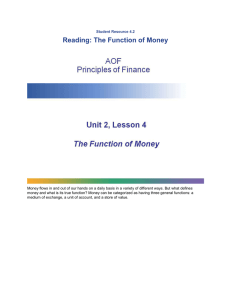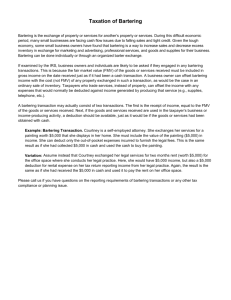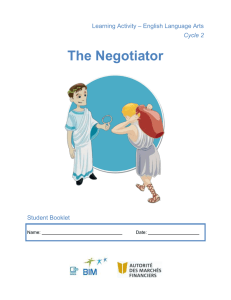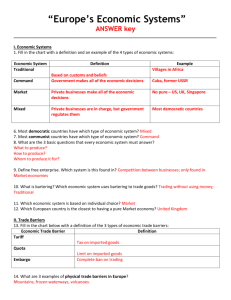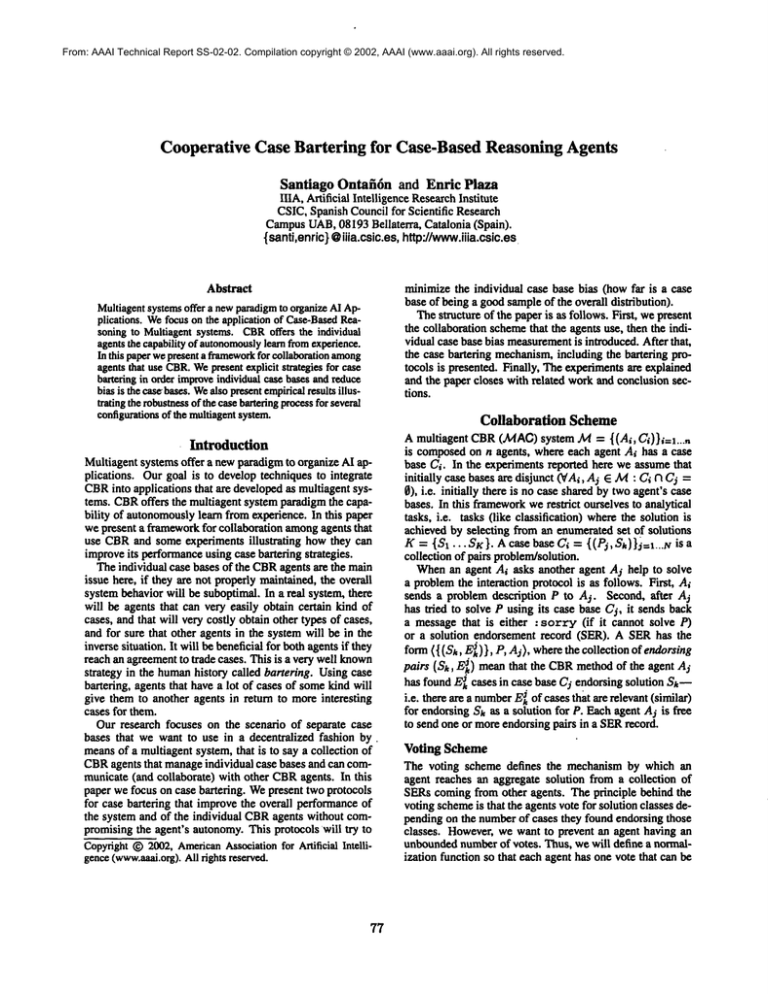
From: AAAI Technical Report SS-02-02. Compilation copyright © 2002, AAAI (www.aaai.org). All rights reserved.
Cooperative
Case Bartering
for Case-Based Reasoning Agents
Santiago Ontafi6n and Enric Plaza
IIIA, Artificial IntelligenceResearchInstitute
CSIC,SpanishCouncil for Scientific Research
CampusUAB,08193Bellaterra, Catalonia (Spain).
{santi,enric} @iiia.csic.es, http://www.iiia.csic.es.
Abstract
Multiagentsystemsoffer a newparadigm
to organizeAI Applications. Wefocus on the applicationof Case-Based
Reasoning to Muitiagentsystems.CBR
offers the individual
agentsthe capabilityof autonomously
learn fromexperience.
In this paperwepresenta framework
for collaborationamong
agentsthat use CBR.
Wepresentexplicit strategiesfor case
barteringin orderimproveindividualcasebases andreduce
biasis the ease’bases.
Wealsopresentempiricalresultsillustratingthe robustness
of the casebarteringprocessfor several
configurations
of the multiagant
system.
Introduction
Multiagentsystems offer a newparadigmto organize AI applications. Our goal is to develop techniquesto integrate
CBR
into applications that are developedas multiagentsystems. CBRoffers the multiagent systemparadigmthe capability of autonomously
learn from experience.In this paper
we present a frameworkfor collaboration amongagents that
use CBRand someexperiments illustrating howthey can
improveits performanceusing case bartering strategies.
The individual case bases of the CBRagents are the main
issue here, if they are not properly maintained,the overall
systembehaviorwill be suboptimal.In a real system, there
will be agents that can very easily obtain certain kind of
cases, and that will very costly obtain other types of cases,
and for sure that other agents in the systemwill be in the
inversesituation. It will be beneficialfor bothagentsif they
reach an agreementto trade cases. This is a very well known
strategy in the humanhistory called bartering. Usingcase
bartering, agents that havea lot of cases of somekindwill
give themto another agents in return to moreinteresting
cases for them.
Our research focuses on the scenario of separate case
bases that we want to use in a decentralized fashion by.
meansof a multiagentsystem, that is to say a collection of
CBRagents that manageindividual case bases and can communicate(and collaborate) with other CBRagents. In this
paper we focus on case bartering. Wepresent two protocols
for case bartering that improvethe overall performanceof
the systemand of the individual CBRagents without compromisingthe agent’s autonomy.This protocols will try to
Copyright(~ 2002,American
Associationfor Artificial Intelligence(www.aaai.org).
All rights reserved.
77
minimizethe individual case base bias (howfar is a case
base of being a goodsampleof the overall distribution).
Thestructure of the paperis as follows. First, wepresent
the collaborationschemethat the agents use, then the individual case base bias measurement
is introduced.After that,
the case bartering mechanism,
including the bartering protocols is presented. Finally, Theexperimentsare explained
and the paper closes with related workand conclusionsections.
Collaboration Scheme
A multiagent CBR(.MAC)system .M = ~(Ai, Ci)]i=l...n
is composedon n agents, where each agent AI has a case
base Ci. In the experimentsreported here we assumethat
initially case bases are disjunct ~A~, Aj E .M: C~t3 Cj =
0), i.e. initially there is no case sharedby twoagent’scase
bases. In this framework
werestrict ourselvesto analytical
tasks, i.e. tasks (like classification) wherethe solution
achieved by selecting from an enumeratedset of solutions
K = {$1...Sg}. A case base C~ = {(Pj,Sh)}j=I..N is a
collection of pairs problem/solution.
Whenan agent Ai asks another agent Aj help to solve
a problemthe interaction protocol is as follows. First, AI
sends a problem description P to Aj. Second, after Aj
has tried to solve P using its case base Cj, it sends back
a messagethat is either :sorry (if it cannot solve P)
or a solution endorsement record (SER). A SERhas the
form({ (Sk, E~)},P, Aj), wherethe collection of endorsing
pairs (Sk,E~) mean that the CBRmethodof the agentAj
has foundE]c cases in case base Cj endorsingsolution Sk-i.e. there are a number
E~of casesthat are relevant(similar)
for endorsingSk as a solution for P. Eachagent Aj is free
to send one or moreendorsingpairs in a SERrecord.
Voting Scheme
The voting scheme defines the mechanismby which an
agent reaches an aggregate solution from a collection of
SERscomingfrom other agents. The principle behind the
voting schemeis that the agentsvote for solution classes dependingon the numberof cases they found endorsing those
classes. However,we want to prevent an agent having an
unboundednumberof votes. Thus, we will define a normalization function so that each agent has one vote that can be
for a uniquesolution class or fractionally assignedto a number of classes dependingon the numberof endorsingcases.
Formally,let.At the set of agentsthat havesubmittedtheir
SERsto the agent As for problemP. Wewill consider that
At E .At andthe result of Attrying to solveP is also reified
as a SER.Thevote of an agent Aj 6 .At for class Sk is
Vote(sk,
c + E,=I...KEJ
wherec is a constant that on our experimentsis set to 1. It
is easy to see that an agent can cast a fractional vote that
is alwaysless than 1. Aggregatingthe votes from different
agents for a class Sk we haveballot
Ballott(S,,At)=
E Vote(S,,Aj)
t
AjE~
and therefore the winningsolution class is the class with
morevotesin total, i.e.
Solt (p,.At) = at# kma..x.x Ballot(Sk, .At)
This voting schemecan be seen as a variation of Approval Voting (Brains &Fishburn 1983). In ApprovalVoting each agent vote for all the candidatesthey consider as
posible solutions withoutgiving any weightto its votes. In
our scheme, Approval Voting can be implementedmaking
Vote(Sk, Aj) - 1 if E]~ # 0 and 0 otherwise.
There are two differences betweenthe standard Approval
Voting and our voting scheme.The first one is that in our
voting schemeagents can give a weight to each one of its
votes. The seconddifference is that the sumof the votes
of an agent is boundedto 1. Thuswe can call it BoundedWeightedApprovalVoting (BWAV).
In the experimentssection we will showsomeexperimentsillustrating the effect of
changingthe voting scheme.
Wewill show nowthe Committeecollaboration policy
that uses this voting scheme(see (Ontafi6n &Plaza 2001)
for a detailed explanationand comparisonof several collaboration policies).
Committee Policy
In this collaboration policy the agent membersof a .MAC
system.A4 are viewedas a committee.Anagent At that has
to solve a problemP, sends it to all the other agents in .M.
Eachagent Aj that has received P sends a solution endorsementrecord ({(Sk, E~)}, P, Aj) to At. The initiating agent
As uses the voting schemeaboveuponall SERs,i.e. its own
SERand the SERsof all the other agents in the multiagent
system. The problem’s solution is the class with maximum
numberof votes.
Noticethat the agents participating in the Committee
Policy haveno reasonor incentive to lie whenprovidinga SER.
First of all, it is rational for an agent to participate in the
CommitteePolicy because it improvesthe accuracy of the
agent itself in classification. Secondly,oncean agent has
joined the CommitteePolicy there is no incentive to cheat
the others (there is no benefit in the others beingworse).
the contrary, if agents start to cheat causingthe Committee
78
Policy accuracyto diminish, the agents woulddecide simply to leave the CommitteePolicy. Thus, it is rational to
participate in the CommitteePolicy and cheating provides
no immediateor long term benefit.
Noticethat the agents haveno incentiveto lie in its SERs,
since their only goal is to improveaccuracyby cooperating.
Whenan agent At asks counsel of another agent Aj, Aj has
no incentive to lie becausethe outcomeof the voting scheme
will only be used by As. Moreover,Aj in the future may
need the help of As expecting a sincere answerfrom him.
Therefore, the agents will only obtain somebenefit of the
collaborationwith other agentsif all themare sincere.
Case Base Bias
In a previous work(Ontafi6n &Plaza 2001) we showedhow
agents can obtain better results using the Committee
collaboration policy that workingalone. However,in those experimentswe assumedthat every agent had a representative
sampleof cases in its ease base. Whenan agent has a case
basethat is not representativeof the overalldistribution, we
say that the agent has a biased case base.
In this section we are going to define a measureof the
degree of biasing of an individual case base (ICB bias or
Individual CaseBasebias), then we will showhowthe performanceof the Committeedegradesas the ICBbias of the
agents grow.Later sections introducebartering policies to
improvethe Committeeperformance.
Individual Case Base Bias
Let be dt = {d~,..., d~} the individual distribution of
cases for an agent As, whered~ is the numberof cases with
solution Sj in the the case base of As. Now,wecan estimate
the overall distribution of cases D = {D1,..., D/c} where
Di is the estimatedprobabilityof the class St,
oJ=
~"~4=1 dt
Tomeasurehowfar is the case baseCi of a given agent Ai
of being a representative sampleof the overall distribution
we will define the Individual CaseBase (ICB)bias, as the
square distance betweenthe distribution of cases Dand the
(normalized)individual distribution obtainedfromdi:
rcB(ct) =
1=1
j=l
In order to see howthe ICBbias affects the performance
of the system,TableI showsthe accuracyof several multiagent systemswith increasing ICBbias (the .MAO
ICBbias is
calculatedas the meanof all the ICBbias of the agentsin the
system). There we can see that whenthe agents have case
bases that are not representative(those witha highICB)the
agents using the Committeepolicy obtains loweraccuracies.
In the followingsections, we will showhowcase bartering
improvesaccuracyby loweringthe individual biases.
MAC ICB
0.O
0.1
0.2
3 Ag.
88.36%
86.07%
81.46%
5 Ag.
8Ag.
10 Ag.
88.12% 87.50% 86.75%
87.50% 85.35% 85.00%
83.53% 83.00% 82.00%
Table1: Classification accuracyfor the marinespongeclassification problemfor systemswith several meanIndividual
Case Basebias.
Case Bartering
In the physical world, bartering involvesthe interchangeof
twogoods.But as our agents will barter with cases (that are
just information)they will only send a copyof the cases to
the other agents without losing them. It’s a matter of the
internal case deletion policy of each agent if a case mustbe
forgotten or not. Deletionpolicies havebeenstudied (Smyth
&Keane1995)but we will not be considering themin these
experiments.
In this section, weare goingto presentthe CaseBartering
protocol that the agents use in order to improvethe overall
performance.
Case Bartering Mechanism
To reach a bartering agreementfor bartering betweentwo
agents, there mustbe an offering agent Ai that sends an offer to another agent Aj. Then Aj has to evaluate whether
the offer of interchangingcases with A~is interesting, and
accept or reject the offer. If the offer is confirmed,wesay
that Ai and Aj have reacheda bartering agreement,and they
will interchangethe cases in the offer.
Formallyan offer is a tuple o =( A~, A j, Ski, Sk2 ) where
A~is the offering agent, Aj is the receiver of the offer, and
St~ and Sk2are two solution classes, meaningthat the agent
AI will send one of its cases with solution Sk2 and Ai will
send one of its cases with solution 5kl.
Makingand accepting offers
The CaseBartering Protocol is not restrictive in howmany
offers can an agent send at a time. So, manystrategies can
be used here, but in our experiments,the agents use a very
simple one to choosewhichare the most interesting offers,
as followsfor a givenagent Ai:
¯ For each solution class Ski E {Sx ...SK}
¯ Ai looks if increasing by one its numberof cases with
solution Stc, will decreaseits ICBbias.
¯ If so, Ai chooseswhichagent Aj of the others is the best
one to ask for cases of solution Skt (Currentlythe chosen
Aj is the one with morecases of the solution class Sk~).
¯ NowA~determineswhichis its best class St,2 (the class
for whichit has more cases), and makesthe offer o
(Ai, Aj, Skt, Sk~), i.e. Ai offers to Aj a case of solution
Sk2 if Aj gives one of solution Ski to Ai.
Whenan agent receives a set of offers, it has also to
choose whichof these offers to accept and whichnot. In
our experimentsthe agents use the simple rule of accepting
79
every offer that reduces its ownICBbias. Thus, wewill define the set of interestingoffers Interesting(O,A~)of a set of
offers O for an agent Ai as those offers that will reducethe
ICBbias of A~. Moreover,an agent cannot send twice the
samecase to the sameagent. So, the agents will only accept
those interesting offers that can satisfy (i.e. can provide
newcase for interchanging).
Case Bartering Protocol
Weare goingto present twodifferent protocols for CaseBartering, bothsynchronous
(i.e. there are preestablishedstages
("rounds") wherethe agents can send their offers, then the
protocolmovesto the next stage, etc). Thefirst one is called
the SimultaneousCaseBartering Protocol, and the second
one the Token-PassingCaseBartering Protocol.
Whenan agent memberof the .MAG
wants to enter in the
bartering process, is sends an initiating messageto all the
other agents in the A4AC.Thenall the other agents answer
whetheror not they enter the bargainingprocess. Thisinitiating messagecontains a parametertR, correspondingto the
timethat eachroundof the protocolwill last.
Simultaneous Case Bartering Protocol In this protocol,in every roundall the agents send their offers simultaneously. Whenall the offers havebeen sent, all the agents
send a messagefor the offers they accept.
1. Eachagent Ai broadcastsits individual distribution d~.
2. Eachagent computesthe overall distribution estimation
D.
3. Theagents send their bartering offers.
4. Eachagent chooses a subset of acceptedoffers from the
set of receivedoffers fromthe other agents and sendsaccept messages.
5. Whenthe maximum
time tR is over, all the unaccepted
offers are considers!as rejected.
6. Eachagent that has somebartering agreementssends the
cases to interchangeto the correspondingagents.
7. Eachagent broadcastsits newindividual distribution d~.
8. If there havebeenno interchangedcases, the CaseBartering Protocolends, otherwisego to 3.
Token-Passing Case Bartering Protocol The main difference betweenthis protocoland the previousone is the introduction of a Token-Passingmechanism,so that only the
agent whohas the Tokencan makeoffers to the others.
Eachagentbroadcastsits local statistics d~.
.
2. Eachagent computesthe overall distribution estimation
D.
Eachagent computesthe ICBbias of all the agents tak,
ing part in the bartering(includingitself), and sorts them.
This defines the order in whichthe Tokenwill be passed
through.
4. The agent with higher ICBbias is the first to have the
Token.
5. Theagent whohas the Tokensends its bartering offers.
Accuracy
comparisonusing Nearest Nelghbour
Accuracycomparisonusing 3-Nearest NMghbour
91
891
:
m..--.
I~
87’
83’
81’
.
,
79’
77’
7S
3
$
8
Numberof agents
I0
$
8
10
Numberof agents
Figure 1: Accuracycomparisonof systems wherethe agents
use nearest neighborwith and without using case bartering
6. Eachagent choosesa subset of accepted offers from the
set of received offers fromownerof the token and sends
accept messages.
7. Whenthe maximum
time tR is over, all the unaccepted
offers are consideredas rejected.
8. Eachagent that has somebartering agreementssends the
cases to interchangeto the correspondingagents.
9. Eachagent broadcastsits newindividual distribution dl.
10. If the Tokenbelongsto the last agent, go to 1 l, otherwise
the Tokenis givento the next agent and wego to 5.
1 I. If there havebeenno interchangedcases, the CaseBartering Protocolends, otherwisego to 3.
Protocol discussion
In bothprotocols,if an offer is not acceptedneither rejected
withinthe periodtimetR, the offer is consideredas rejected,
and the protocol movesto the next round.
To ensure the convergence of both protocols, we have
only to have in mindthe only restriction that wehave imposed: an agent cannot send twice the samecase to the same
agent. Withthis restriction it’s easyto see that both protocols cannot run indefinitely, becauseeach agent has a limited numberof cases to trade with. So, we can say that in a
boundednumberof rounds both protocols will end.
Comparing
the protocols, we can see that the Siraultaneous protocol has the problemthat an agent has to decide if
accept offers or not without knowingif its ownoffers are
going to be accepted. The Token-Passingprotocol tries to
solve this problemby letting only one agent to sendoffers at
a time.
Experimental
results
In this section we wantto showhowthe classification accuracy of the agents improveusing the case bartering protocols with respect to systems wherethe agents do not use
them. Wealso showresults concerningcase base sizes after
8O
Figure 2: Accuracycomparisonof systems wherethe agents
use 3-nearest neighborwith and withoutusing case bartering
¯
.
’"
i
.
3
5
6
10
Numberof agents
Figure 3: Accuracycomparisonof systems wherethe agents
use LIDwith and without using case bartering
the bartering and the numberof rounds neededto converge
to a stable case distribution.
Weuse the marinespongeidentification (classification)
problemas our test bed----this data set wasalso usedto assess the relational inductive method!NDIE
in (Armengol
Plaza 2000). Spongeclassification is interesting because
the difficulties arise from the morphologicalplasticity of
the species, and from the incomplete knowledgeof many
of their biological and cytological features. Moreover,benthologyspecialists are distributed aroundthe worldand they
haveexperiencein different benthosthat spawnspecies with
different characteristics dueto the local habitat conditions.
In order to showthe improvements
obtained in the system
whenthe agents use case bartering, we havedesignedan experimentalsuite with a case base of 280marinespongespertaining to three different orders of the Demospongiae
class
(Astrophorida, Hadromerida
and AxineUida).In an experimentalrun, cases are randomlydistributed amongthe agents
(e.g. if the training set is composed
of 252cases and wehave
.MAGICB bias
Before
After SCBP
After TPCBP
20C
18C
3Ag.
5 Ag.
0.2
0.2
0.000040.0003
0.00003 0.0002
8 Ag. lO Ag.
0.23
0.15
0.0004 0.0004
0.0002 0.0003
18C
Table 2: MAC
ICBbiases of the multiagent systems used in
the experimentsbefore and after the case battering process.
12C
10©
SCBP
TPCBP
SCBP*n
¯ ..m m
m
-.,(
3
5
8
I0
3 Agents 5 Agents 8 Agents l OAgents
24.9
79.4
14.0
12.9
212.0
101.1
97.2
99.4
238.2
124.5
112.0
129.0
Table 3: Numberof rounds need to converge in the case
bartering protocols.
Number of agents
Figure 4: Comparison
of the case base size before and after
the bartering process
a 4 agents system, each agent will receive about 63 cases).
In the testing phase, problemsarrive randomlyto one of the
agents. Thegoal of the agent receiving a problemis to identify the correct biological order given the description of a
newsponge. Oncean agent has received a problem,he will
use the Committee
collaborationpolicy to obtain the prediction.
For experimentationpurposes, weforce biased case bases
in every agent. Specifically, weincrease the probability of
each agent to have cases of someclasses and decrease the
probability to havecases of someother classes. For example, in the 3 agent scenario, the 70%of the cases for the
class Astrophoridain the training set are in the individual
case base of Agent1, and the other two agents only have
a 15%of them. Analogously,the 70%of the cases for the
classes Hadromerida
and Axinellida are in the case bases of
the Agents2 and 3 respectively. This process increases the
individualcase-basebias of the agents in the .MAC;
the first
row of Table 2 showsthe averageover Individual Case-Base
(ICB)biases for the agents in the experiments.
Table2 also showsthe averageICBbiases for the agents
in the experimentsafter the bartering process. Wecan see
that both protocols ate able to reduce the ICBbias to very
small values. This showsthat the bartering protocols effectively interchangecases until all agents drastically reduce
their 1CBbias; only then the process ends and the overall
accuracy has indeed improvedto the level we expected. Finally, notice that whenagents havea greater volumeof cases
to barter (e.g. in the 3 agents scenario) the ICBbias obtained after bartering is one order of magnitudelowerthan
whenthe agents have fewer cases (from 0.00003in 3 agents
scenario to 0.0003in the 10 agents scenario).
In order to test the generality of the protocols, wehave
tested themusing systemswith 3, 5, 8 and up to 10 agents,
and using several CBRmethods:nearest neighbor, 3-nearest
neighbor and LID (Armengol& Plaza 2001). The results
presentedhere are the averageof 5 10-fold cross validation
runs.
81
The figures 1, 2 and 3 showthe results of applying the
two case bartering protocols. Threebars are shownfor each
scenario, the biased results represent the averageaccuracy
obtained by the .MAC
without using case-bartering with biased individual case bases; and the SCBPandTPCBP
results
represent the average accuracy obtained by the .MAC
after
using the SynchronousCase Bartering Protocol and TokenPassingCaseBarteringProtocolrespectively. Wecan see in
those figures that in all the scenarios, the .MAC
systemsusing case barteringobtaina significative gain in accuracythan
those systems that do not use case bartering. This shows
the independenceof the bartering protocols from the CBR
methodused by the individual agents. Those figures also
showthat case bartering is robust evenwhenthe size of the
case bases decreases and the numberof cases an agent can
barter is verysmall, as wecan see for the 10 agentsscenario
whereeach agent has only about 25 cases (i.e. less than
casesper class).
Comparingthe accuracy obtained by the two protocols
SCBPand TPCBP
we see that both have nearly the sameaccuracyin all the scenarios. Wecan see that there is nevera
difference greater than 1%betweenthe results of the Simultaneous protocol and the results of the Token-Passingprotocol. Thereforeno bartering protocolis significantly better
than anotherbut both are significantly better than using no
bartering protocol.
Figure 4 showsthe case base sizes reached after case
bartering. Wesee that the agents stop interchangingcases
before each agent acquires all knowncases in the system.
Moreover,except in the 3 agents scenario, the case base
sizes do not increase very much.The 3 agents scenario
is special becausethe initial case bases of the agents are
quite big, and to repair their ICBbiases the numberof cases
neededto be bartered is muchgreater than in the 5, 8 or 10
agent scenarios. Wealso see that the case base sizes obtained using the Token-Passing
protocol are slightly smaller
than the ones obtained using the Simultaneousprotocol.
Concerningto the convergenceof the protocols, they alwaysconverge. Table 3 showsthe average numberof rounds
needto convergein both protocols. Wecan see that the Simultaneousprotocol is muchfaster than the Token-Passing
one (taking only in considerationthe numberof roundsneed
Voting
Scheme
comparison
using
3-Nearest
Nelghbout
91
83
Figure 5: Comparisonbetween Bounded.WeightedApproval
Voting and standard ApprovalVoting for agents using LID.
to converge).Thisis as expected,since in the Token-Passing
protocol only one agent can makeoffers each round, so
TPCBP
needs about n times more rounds (being n the number of agents in the system) than the Simultaneousprotocol. Thethird row of table 3 showsthe numberof roundsof
the Simultaneousprotocol multiplied by n. Wesee that the
numberof rounds needed by the Token-Passingprotocol is
alwaysa bit less than those numbers.
For comparisonpurposes Figures 5 and 6 showsomeresults wherethe agents use standard ApprovalVoting instead
of the Bounded-Weighted
Approval Voting. These figures
showa comparisonbetweenthe two voting schemesfor two
different scenarios: in the first one the agents do not use
case-bartering, and in the second one they use the SCBP.
Theresults showthe accuracy for LIDand 3-NearestNeighbour (since in l-Nearest Neighbouragents vote for only one
class, there is no difference betweenAVand BWAV).
Figures
5 and 6 showthat there is no significant difference between
the two voting schemes. Whenthe agents use LID BWAV
worksbetter for systemswherethere are fewer agents (and
thus more cases per case-base). But whenthe agents use
3-Nearest Neighbourthis difference is not so clear. When
the case-bases are biased, standard AVis worse than BWAV
with 3-Nearest Neighbour(specially in the 3 and 8 agents
scenario). However,after the bartering process (whenICB
bias is low), both voting schemesobtain nearly the sameresuit. Sumarizing,both voting schemesbehavesimilarly, but
BWAV
is morerobust with higher biased conditions.
Related Work
Several areas are related to our work:multiple modellearning (where the final solution for a problemis obtained
throughthe aggregationof solutions of individual predictors), case base competenceassessment, and negotiation
protocols. Herewe will briefly describe somerelevant work
in these areas that is close to us.
A general result on multiple modellearning (Hansen
Salamon1990)demonstratedthat if uncorrelated classifiers
82
Figure 6: ComparisonbetweenBounded-WeightedApproval
Voting and standard ApprovalVoting for agents using 3nearest neighbour.
with error rate lowerthan 0.5 are combined
then the resulting error rate must be lower than the one madeby the individual classifiers. The BEM(Basic EnsembleMethod)
is presented in (Perrone & Cooper1993) as a basic way
to combinecontinuous estimators, and since then many
other methodshave been proposed:Stacking generalization
OVolpert1990), Cascadegeneralization (Gama1998), Bagging (Breiman1996) or Boosting (Freund &Scbapire 1996)
are someexamples.However,all these methodsdo not deal
with the issue of "partitioned examples"amongdifferent
classifiers as wedo--they rely on aggregatingresults from
multipleclassifiers that haveaccessto all data. Theirgoal is
to use multiplicityof classifiers to increaseaccuracyof existing classification methods.Ourintention is to combinethe
decisions of autonomous
classifiers (each one corresponding
to one agent), and to see howcan they cooperateto achieve
a better behavior than whenthey workalone. A moresimilar approachis the one proposedin (Vuurpijl &Schomaker
1998), wherea MAS
is proposed for pattern recognition.
Eachautonomousagent being a specialist recognizing only
a subset of all the patterns, and wherethe predictions were
then combineddynamically.
Learning from biased datasets is a well knownproblem, and manysolutions have been proposed. Vucetic and
Obradovic (Vucetic & Obradovic 2001) propose a method
basedon a bootstrap algorithmto estimate class probabilities in order to improvethe classification accuracy. However, their methoddoes not fit our needs, becausethey need
the entire testset availablefor the agentsbeforestart solving
any problemin order to makethe class probabilities estimation.
Related workis that of case base competenceassessment.
Weuse a very simple measure comparingindividual with
global distribution of cases; wedo not try to assess the aeras
of competenceof (individual) case bases - as proposed
Smytb and McKenna(Smyth & McKenna1998). This work
focuses on finding groupsof cases that are competent.
In (Schwartz & Kraus1997) Schwartzand Kraus discuss
negotiation protocols for data allocation. Theyproposetwo
protocols, the sequential protocol, andthe simultaneousprotocol. Thesetwo protocols can be comparedrespectively to
our Token-Passing CaseBartering Protocol and Simultaneous CaseBartering Protocol, becausein their simultaneous
protocol, the agents haveto makeoffers for allocating some
data item withoutknowingthe other’s offers, and in the sequential protocol, the agents makeoffers in order, and each
one knowswhichwere the offers of the previous ones.
Conclusions and Future Work
Wehave presented a frameworkfor cooperative Case-Based
Reasoningin multiagentsystems, whereagents use a market
mechanism(bartering) to improvethe performanceboth
individuals and of the wholemultiagent system. The agent
autonomyis maintained, because if an agent do not want
to take part in the bartering, he just has to do nothing,and
whenthe other agents notice that there is one agent not followingthe protocol they will ignore it during the remaining
iterations of the barteringprocess.
In this article wehaveshowna problemarising whendata
is distributed over a collection of agents, namelythat each
agent mayhave a skewedview of the world(the individual
bias). Comparing
empiricalresults in classification tasks we
sawthat both the individual and the overall performancedecreases whenbias increases. The process of bartering shows
that the problemsderived fromdistributed data over a collection of agents can be solved using a market-orientedapproach. Eachagent engagesin a barter only whenit makes
sense for its individual purposesbut the outcomeis an improvementof the individual and overall performance.
The naive wayto solve the ICB bias problem could be
to centralize all data in one location or adopt a completely
cooperative multiagentapproachwhereeach agent sends its
cases to other agents and they retain whatthey want(a "gift
economy").The problem with the completely cooperative
approachis that the outcomeimprovesbut redundancyalso
increases and there maybe scaling up problems;the bartering approachtries to interchange cases only to the amount
that is necessaryand not more.
In the experimentsreported in this paper, the agents use
strategies for choosingwhichoffers to generateand send to
other agents and for choosingwhichoffers to accept from
other agents. Currently, both strategies try to minimizethe
ICBbias measure. The ICB bias estimates the difference
betweenthe individual and global case distribution over the
classes. However,we plan to study other kinds of biases
that maycharacterize the individual agents’ case base. In
order to computethese new bias measures, the agents may
needto makepublic moreinformation. Thus, a modification
in the bartering protocols wouldbe needed to managethe
informationrequired.
Wehavefocusedon bartering for agents using lazy learning but future workshould addressthe usefulnessof bartering for eager (inductive)learning techniques.
83
Acknowledgements
The authors thank Josep-Liufs Arcos and Eva Armengolof
the IIIA-CSICfor their support and for the development
of the Noos agent platform and the LID CBRmethodrespectively. Support for this workcamefrom CIRITFI/FAP
2001 grant and projects TIC2000-1414"eInstitutor" and
ISTo 1999-19005 "IBROW".
References
Armengol,E., and Plaza, E. 2000. Bottom-upinduction of
feature terms. MachineLearningJournal 41(1):259-294.
Armengol,E., and Plaza, E. 2001. Lazyinduction of descriptions for relational case-basedlearning. In 12thEuropean Conferenceon MachineLearning.
Brams,S. J., and Fishburn, P. C. 1983. ApprovalVoting.
Birkhauser, Boston.
Breiman,L. 1996. Baggingpredictors. MachineLearning
24(2): 123-140.
Freund, Y., and Schapire, R. E. 1996. Experimentswith a
newboosting algorithm. In Proc. 13th International Conference on Machine Learning, 148-146. MorganKaufmann.
Gama,J. 1998. Local cascade generalization. In Proc.
15th International Conf. on MachineLearning, 206-214.
MorganKaufmann,San Francisco, CA.
Hansen,L. K., and Salamon,P. 1990. Neural networksensembles. IEEETransactions on Pattern Analysis and Machine Intelligence (12):993-1001.
Ontafi6n,S., and Plaza, E. 2001.[,earning whento collaborate amonglearning agents. In 12th EuropeanConference
on MachineLearning.
Pert’one, M. P., and Cooper, L.N. 1993. Whennetworksdisagree: Ensemblemethodsfor hydrid neural networks.In Artificial NeuralNetworksfor SpeechandHsion.
Chapman-Hall.
Schwartz, R., and Kraus, S. 1997. Bidding mechanisms
for data allocation in multi-agent environments.In Agent
Theories, Architectures, and Languages,61-75.
Smyth, B., and Keane, M.T. 1995. Remembering to
forget" A competence-preserving
case deletion policy for
case-based reasoning systems. In IJCAI, 377-383.
Smyth, B., and McKenna,E. 1998. Modelling the competence of case-bases. In EWCBR,
208--220.
Vucetic, S., and Obradovic,Z. 2001. Classification on data
with biased class distribution. In 12th EuropeanConference on MachineLearning.
Vuurpijl, L., and Schomaker,L. 1998. A frameworkfor
using multiple classifiers in a multiple-agentarchitecture.
In Third International Workshopon HandwritingAnalysis
and Recognition.
Wolpert, D.H. 1990. Stacked generalization. Technical
Report LA-UR-90-3460,Los Alamos, NM.

